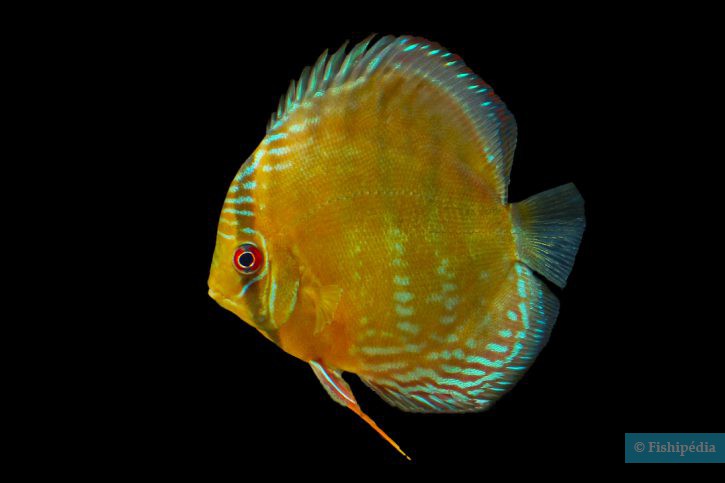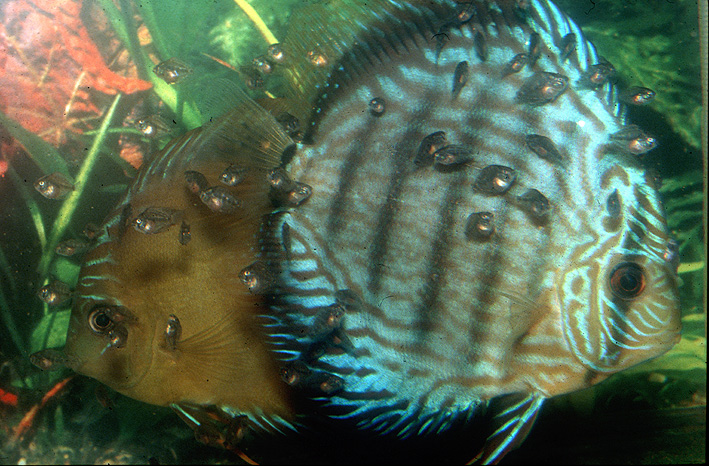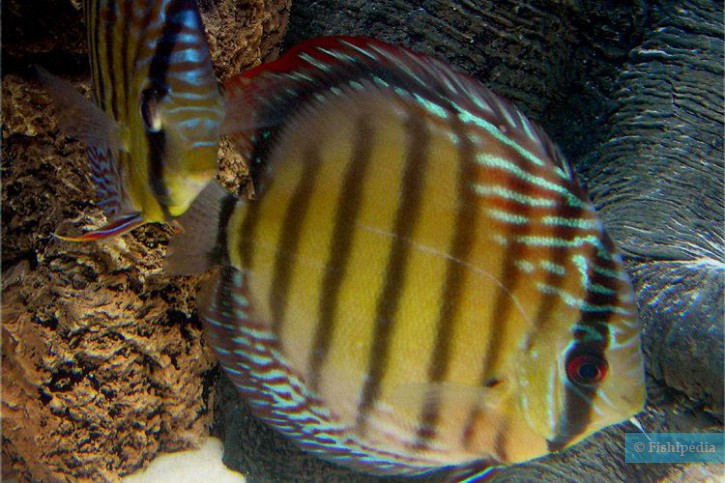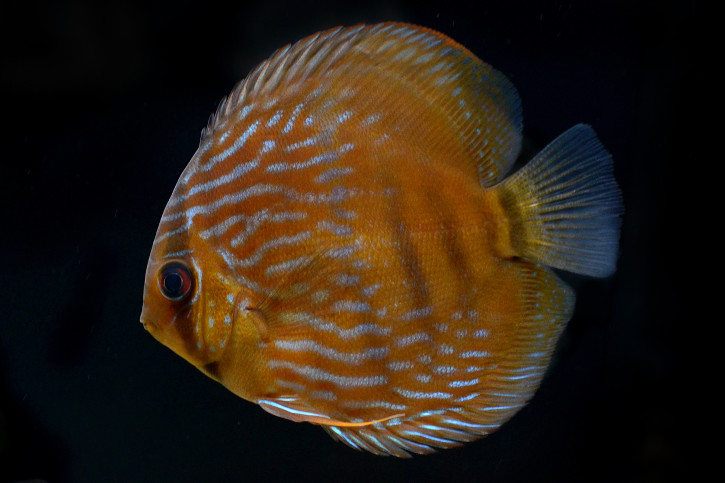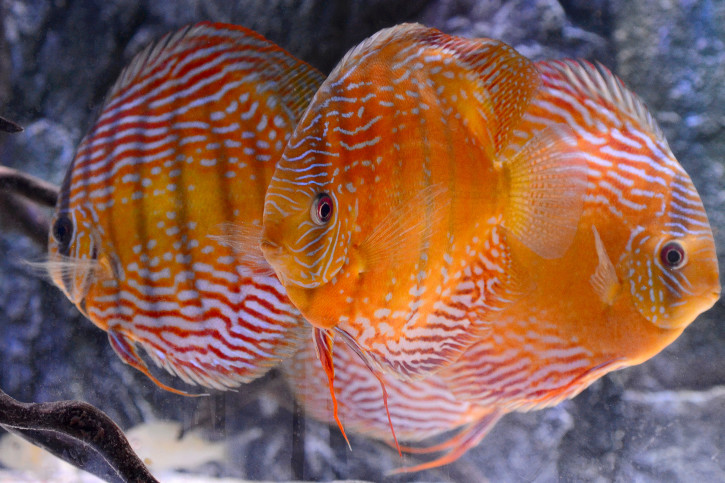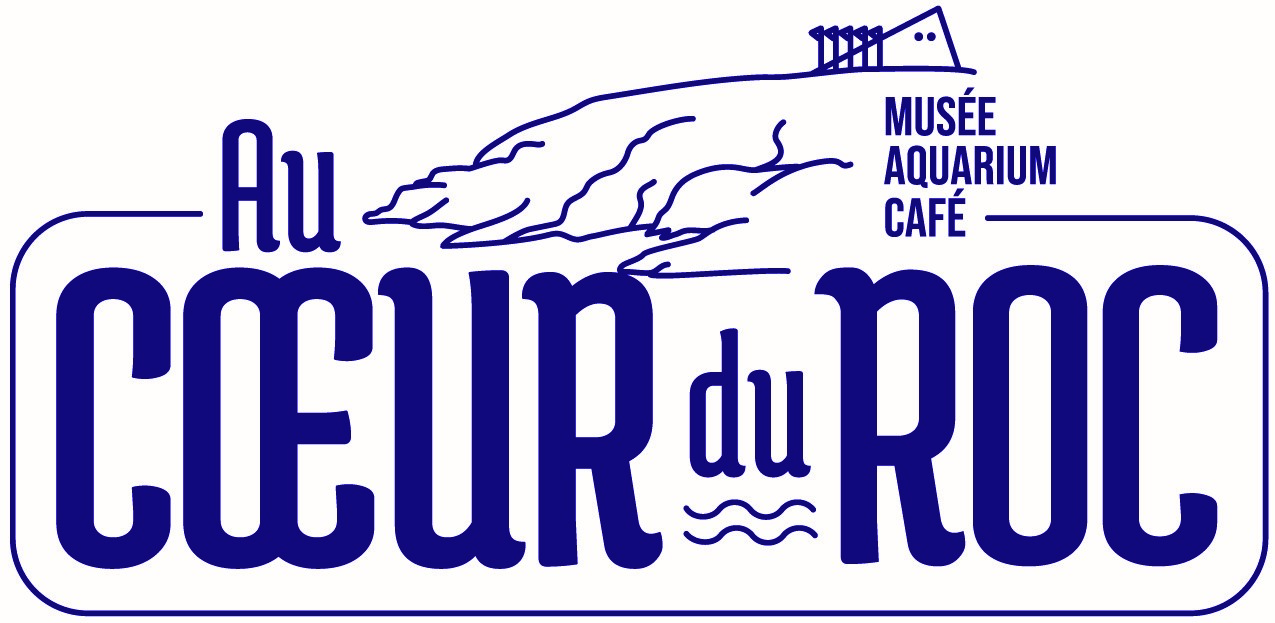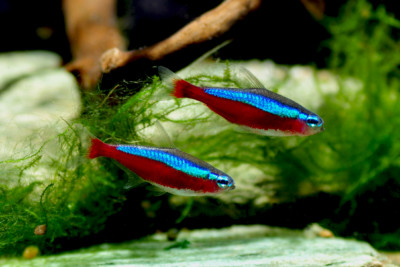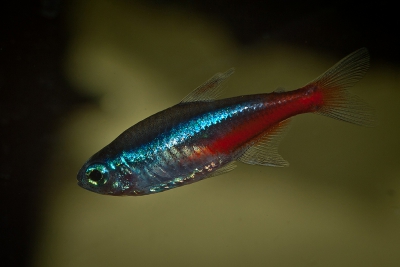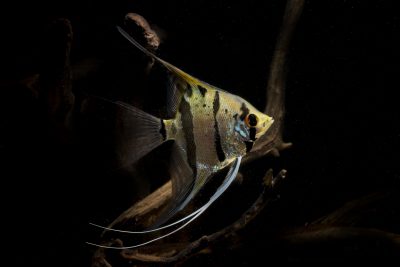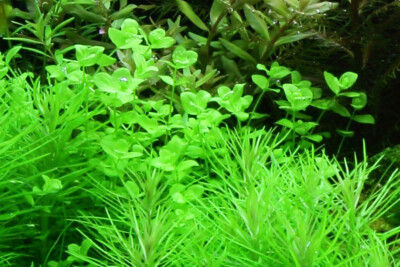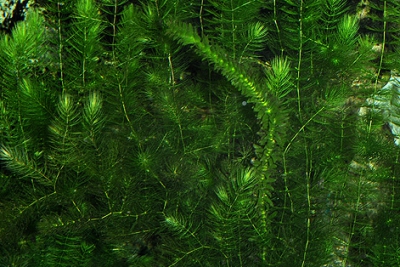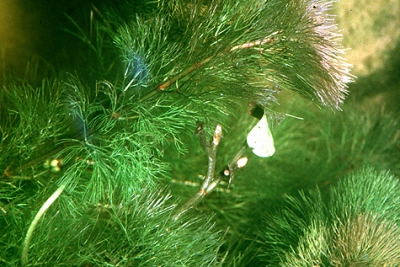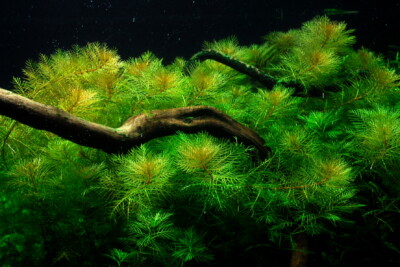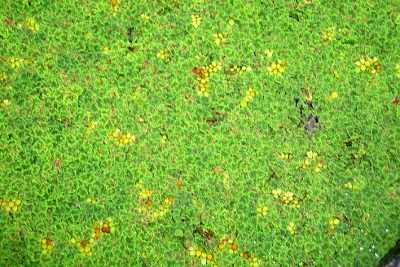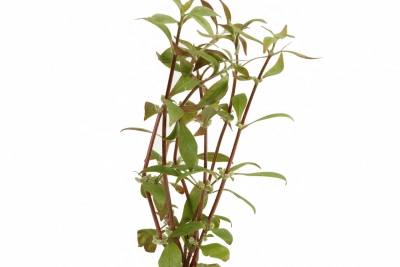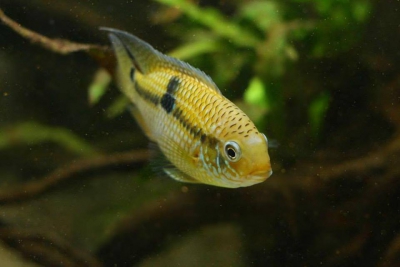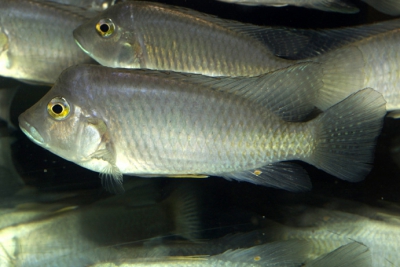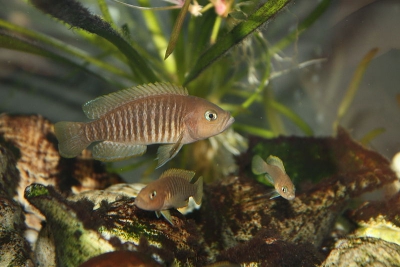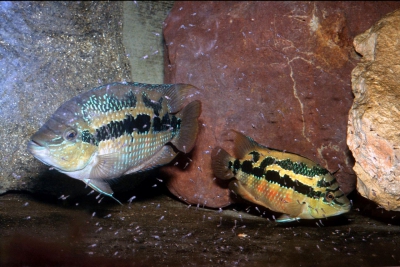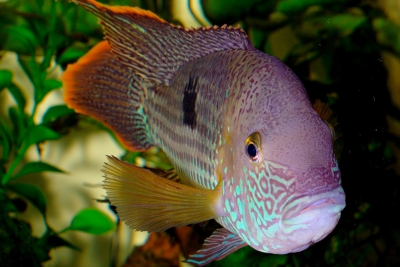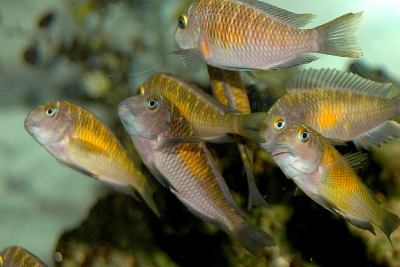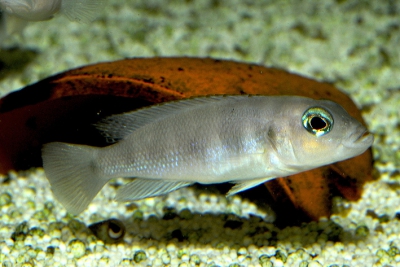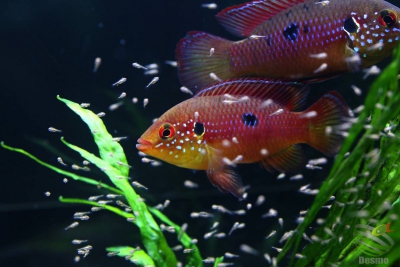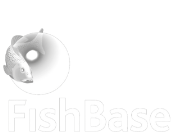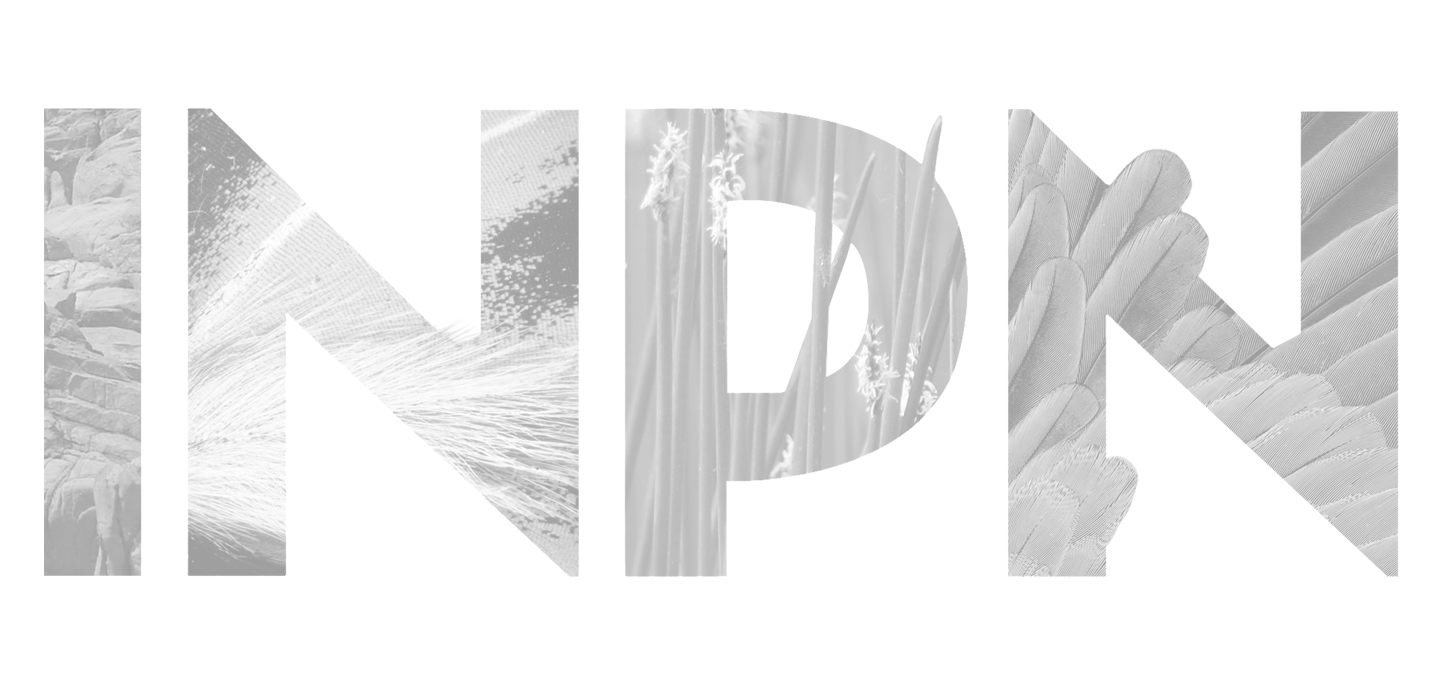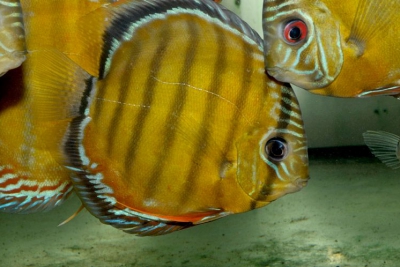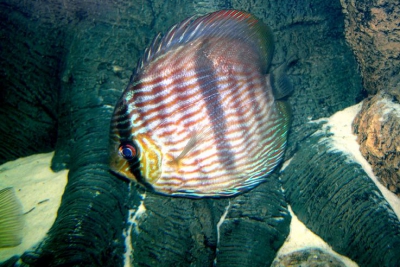blue discus
| Family | Cichlidae |
|---|---|
| Genus | Symphysodon |
| IUCN category (World) | LC |


Introduction
Symphysodon aequifasciatus, commonly known as the blue discus, is a tropical fish native to South America. It is one of the few freshwater species that has a disc-shaped body.
Who is it?
Genus Symphysodon
Fish of the genus Symphysodon are commonly called discus. They belong to the group of "cichlasomatines," which includes several other species of compressed-bodied cichlids that inhabit similar biotopes. Examples include the genera Heros, Uaru, Pterophyllum, or Mesonauta.
Discus share some character traits with species from the previously mentioned genera. Rare among fishes, they have the peculiarity of producing mucus to feed their juveniles. Worldwide, only these fishes and Uaru exude this "milk" from their skin.
The number of discus species is still a matter of disagreement among scientists. According to Schultz, two species are recognized: S. aequifasciatus, divided into 3 subspecies, and S. discus Heckel found in the Rio Negro.
In 2006, a DNA-based study showed that the genus has two species: S. aequifasciatus and a new species, S. tarzoo, which includes the "green" and "blue" discus populations previously incorporated into the species S. aequifasciatus. The former S. discus, present east of the Purus arch, belong, according to this model, to the species S. aequifasciatus.
Finally, a 2007 DNA-based study also showed that there are actually three species of discus: S. discus, S. aequifasciatus, and S. haraldi. According to the latter, S. aequifasciatus is the only species found exclusively west of the Purus arch. S. haraldi is widely present around the mouth of the Amazon at the rio Iça. S. discus is limited to the Rio Negro and some tributaries. Hybridizations are common between S. discus and S. haraldi.
On Fishipedia, we have maintained the FishBase classification for the time being, awaiting resolution by scientists of these discrepancies.
A dynamic international trade is organized around the export of wild discus from the Brazilian Amazon. Despite the strong historical interest in discus in the aquarium hobbyist community, studies on the natural habitat of these fishes have long been absent. Much of the literature comes from captive experiments.
Morphology
-
Average size15 cm
-
Maximum size20 cm
-
Longevity12 year
-
ShapeCircular
-
Average size15 cm
-
Maximum size20 cm
-
Longevity12 year
-
ShapeCircular
How to recognize This fish ?
The blue discus is a multicolored fish with a compressed disc-shaped body. Depending on the fishing areas, the patterns can include varying shades of brown, blue, red, or green.
\r\nAccording to Schultz (1960), there are three subpopulations: - S. aequifasciatus aequifasciatus (green discus - mainly from the southern tributaries of the upper Amazon) - S. a. haraldi (blue discus - mainly from the northern tributaries of the upper Amazon) - S. a. axelrodi (brown discus - mainly from the lower Amazon)Sexual dimorphism
These fish are difficult to differentiate. Females have rounded genital papillae pointing backward during breeding, unlike males whose papillae are pointed and directed forward.
Behaviour & Life cycle
-
dietcarnivorous
-
Sociabilityliving as a couple or in a group
-
territorialYes
-
Way of livingdiurnal
The blue discus' habitat is characterized by extreme seasonal fluctuations, resulting in significant behavioral changes in the fish. During the dry season, oxygen and food decrease while parasite and predator densities increase.
\r\nThus, in the "full water" period, the blue discus lives solitarily or in small groups in submerged forests, searching for algae, microorganisms, and plant matter. Conversely, during the dry season, they gather to form colonies of several hundred individuals. At this time, they reside hidden around fallen trees and roots.
\r\nWithin the groups, ritual displays, and even small skirmishes, may occur between the different members until a hierarchy is established.
\r\nWhen the blue discus feel threatened, black vertical stripes appear on their entire body. These patterns, which may then resemble some morphological features of their relatives, likely help them blend more easily in the branches or disrupt the vision of their predators.
Reproduction
-
Reproductionovipare qui pond sur substrat découvert
The blue discus is an oviparous fish that spawns on open substrate. Reproduction occurs at the beginning of the flood season, increasing the survival chances of the offspring. The blue discus reaches sexual maturity within a year.
\r\nFormed couples are strong and take care of their progeny. They protect their nest, feed their fry on their backs. Survival rates depend heavily on flood levels.
Harmless species
This species does not pose a particular danger to humans when encountered in its natural habitat.
Origin and distribution
What is its habitat?
Natural environment characteristics
-
Temperature26 - 30 °C
-
pH (acidity)6 - 7.5
-
gh (hardness)6 - 13
Biotope presentation
The blue discus naturally resides in slightly acidic water, characteristic of tropical and equatorial forest regions. During the dry season, they live in schools near large roots, trees, or branches where they can find refuge in case of danger. During the flood period, groups disperse in the flooded forest.
\r\nThe floodplain systems where the blue discus resides are among the planet's richest ecosystems in terms of species diversity. In these regions, the Amazon River's amplitude is 6 to 12 meters, providing numerous opportunities for food and shelter during floods, and conversely, strong predation pressure during the dry season.
Main recommendations for fishkeeping
Deontology
In order to preserve wildlife, if you acquire this animal, it must not be released into the wild. See also, the Fishipedia charter.
Fishipedia supports the practice of responsible and environmentally friendly aquarium keeping. We encourage maintenance if it is motivated by a desire to understand the biological functioning of living things and if it is done with respect for animal life.
We believe that aquaristics is an opening to the discovery of aquatic environments, especially freshwater, and that this knowledge is necessary to better protect and respect these environments. Logically, we refute the compulsive purchase of animals that would not find a sufficient and / or adapted place in the host aquarium.
Our recommendations
-
Min volume350 liters
-
Population min5
-
Temperature26 - 30 °C
-
pH (acidity)6.8 - 7.2
Characteristics
-
Difficulty breedingmoderate
-
Robustnesssensible
-
Behaviourpeaceful
-
Availabilityusual
Recommended equipment from our partners
-
Aquarium
-
Filtration
General reminders
It is strongly advised to read the complete dedicated file and to get information on the feedbacks of maintenance of the envisaged animal, this to avoid any potential conflict whose end result is generally the death of the individual (or the other inhabitants). It is important not to overload your aquarium to limit pollution. This will make maintenance easier.
In nature, animals are subject to weather conditions and live in waters with variable characteristics. The recommendations offered by our team for aquarium maintenance are a guidance and cannot be assimilated to scientific datas.
General reminder on maintenance datas
Le démarrage d'un aquarium est une partie primordiale pour l'équilibre et le bien-être des poissons. Lorsque l'on met en eau un aquarium, l'eau passe naturellement par un cycle biologique : le cycle de l'azote. Celui-ci dure environ trois semaines. Tous les 2 jours, nous vous conseillons de tester votre eau jusqu'à ce que le taux de nitrite soit à zéro pendant plusieurs jours d'affilée.
Pour accélérer ce cycle, vous pouvez utiliser un activateur de bactéries comme JBL Denitrol. Cette solution riche en bactéries vivantes et enzymes permet une mise en place rapide du cycle de l'azote. Les poissons peuvent alors être introduits plus rapidement.
Il est important de tester l'eau de son aquarium régulièrement pour maintenir un environnement sain pour les poissons et les autres habitants. Les tests d'eau permettent de mesurer les niveaux de différents paramètres tels que le pH, la dureté totale, ainsi que les taux de nitrates, de nitrites et d'ammoniaque.
Pour réaliser ces tests, vous pouvez utiliser des produits d'analyse spécialisés tels que JBL ProScan qui permet de réaliser un diagnostic de l'eau directement via un smartphone. Il existe également des coffrets de tests plus classiques de bandelettes, comme JBL PROAQUATEST.
En cas d’usage de l’eau du robinet, vous pouvez utiliser un conditionneur d’eau de type Biotopol de JBL pour éliminer les substances nocives comme le chlore, le cuivre, le plomb et le zinc. Une eau trop dure ou trop calcaire peut être inadaptée à de nombreuses espèces tropicales d’eau douce. Si nécessaire, vous pouvez la couper avec de l’eau osmosée ou de pluie filtrée afin d’obtenir une dureté plus adaptée aux besoins de vos poissons et de vos plantes. Les conditionneurs d'eau garantissent une meilleure santé aux poissons et une meilleure croissance des plantes.
Chlorine and chloramine are dangerous for the health of animals. Used to disinfect water, these agents are present in significant quantities in tap water. We recommend using an anti-chlorine agent every time you change the water. In addition to chlorine, treatments and medicines sold for aquarium use sometimes contain dangerous heavy metals in high doses.
Specific needs for the blue discus
The blue discus is a species which lives naturally at a temperature between 26 °C and 30 °C. The blue discus is sensitive to abrupt changes in parameters as well as to chemicals. Its acclimation in an aquarium must be done with special care to prevent it from developing diseases or weaknesses. Nitrate levels should remain below 25mg/L. To keep the water clean and unpolluted, plan on changing 20% to 30% of the water volume each month.
The breeding of this species is accessible on condition of being well informed about its needs in aquarium . Any cohabitants must be chosen with care to avoid the loss of animals. This animal is somewhat more sensitive than others to environmental influences and water quality.
This species is particularly common in the aquarium trade. Animals from long-term breeding are usually acclimatized at a temperature of about 26 °C in neutral water.
Cohabitation & Environment
In a community aquarium context, this species should be kept in a minimum volume of 350 liters.
Fearful by nature, it is advised not to let the blue discus cohabit with large territorial species or with too aggressive fish. It can easily evolve with territorial neighbors with a peaceful temperament or with non-territorial species.
Be careful to plan an adequate space for each territorial species. Each species should have a surface and a decor allowing it to juxtapose its territory with that of its neighbors.
The blue discus is a fish that generally lives in groups outside of the reproduction periods. If you want to reproduce them and have a good chance of forming a couple, it is recommended to keep at least 5 individuals.. In a community aquarium, the chances of survival of the larvae are almost null. After a few spawns, it is preferable to isolate the couple or to separate from the other members of the group.
The hierarchical organization and the aggressiveness between fellow fish can weaken certain individuals, the presence of hiding places becomes then necessary. If you wish to add new members, it is better to introduce younger fish. They will have a better chance of integrating into the new balance.
Tips for feeding
The blue discus is carnivorous.
This species can eat dry food (flakes, pellets), fresh food and frozen food. To avoid deficiencies, it is recommended to vary the types of food.
Feed animals in moderation to maintain good water quality. Meals should be eaten within 2–3 minutes, served in several small portions rather than a single large ration.
Uneaten food quickly decomposes, releasing ammonia, nitrites, and nitrates, which disturb the aquarium’s biological balance.
Make sure each species can access food properly, slower or bottom-dwelling individuals may require targeted feeding.Food recommendations from our partner JBL - Products PRONOVO
-
Granules
-
Flakes
Reproduction protocol
-
Maintenance difficultyhard
-
egg-laying protectionYes
Reproduction of this species in an aquarium is considered hard. Ideally, it takes place at a temperature of around 30 ° C for a pH of 6 .
Hybridization risks
In general, it is advised not to mix several species of the same genus or different varieties of the same species, to avoid the risks of hybridization.
These animals might interest you
These plants might interest you
Plants play a crucial role in aquariums, both for their ability to filter water by absorbing excess nutrients and for their aesthetic contribution. They provide fish with natural hiding places, can serve as breeding sites, and generally help maintain the overall balance and optimal conditions of the aquarium. The selection presented here includes species from the same regions as the species described on this page, although they do not necessarily come from its exact natural biotope.
To go further
Sources & Contributions
Participation & Validation
The Fishipedia team and specialist contributors are committed to providing high-quality content. However, although the information comes from scientific sources or testimonials from specialists, the cards may contain inaccuracies.

Benoit Chartrer
Translation
Translation done with the valuable contribution of our translators, who make this information available to a wider audience. We sincerely thank them for their commitment.

Benoit Chartrer
Bibliographic references
- - GBIF
- - Ecology and life history of an Amazon floodplain cichlid: the discus fish Symphysodon (Perciformes: Cichlidae) - Neotropical Ichthyology - 2008. Print version ISSN 1679-6225On-line version ISSN 1982-0224
Scientific partners
Species of the same family
Same genus
